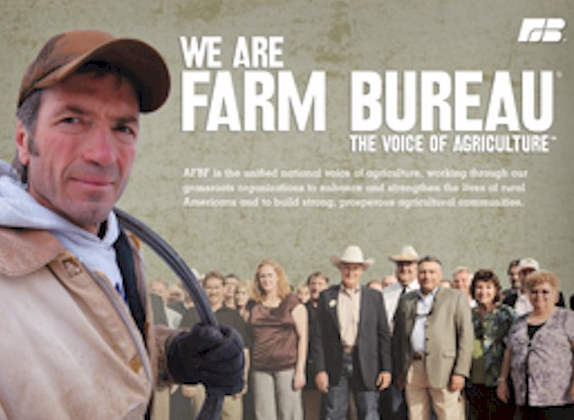
The cover of a Farm Bureau brochure. The subtitle reads: The voice of agriculture.
The Washington Post says that the current drought is the worst in a half-century and the corn harvest will likely be even smaller than the USDA’s recently downsized estimates. The wacky weather in the heart of commodity agriculture country reminds me of something Bob Stallman, president of the American Farm Bureau Federation (AFBF), said a few years ago in a Newsweek interview about farmers’ attitudes toward climate change. It read:
Stallman says most farmers aren’t worried. “We are used to dealing with extreme weather variation,” he says, pointing out that his Texas farm has seen 20 inches of rain in a single day, in the middle of a drought. “We’ve learned to roll with those extremes. If it gets a little more extreme down the road, we can deal with it.”
Yeah. Well, I don’t know how many farmers want to “roll with” this drought. Mr. Stallman, would you like to revise those remarks?
I’m guessing no. After all, the AFBF was instrumental in exempting agriculture from the ill-fated climate bill back in 2009 and Stallman has shown no interest in revisiting the issue. There remains no mention of climate change on the AFBF website.
But Stallman’s climate change denialism is really a sideshow for the AFBF. A new investigative report by Ian Shearn for the Nation (produced in collaboration with the Food & Environment Reporting Network*), explores the full reach of the federation. It’s one that encompasses political activities like lobbying and grooming state legislators sympathetic to its interests as well as vast business interests that have turned what was once a support network for family farmers into large industry players’ most potent ally.
As Shearn details, it’s a much more complex organization than most people realize. A key to understanding the AFBF and its state-level incarnations is the fact that the federation has 6 million members in a nation with only 2 million farmers. But Shearn explains that the federation isn’t entirely what it seems:
It’s not just a non-profit “farmers organization” but a multi-billion dollar network of for-profit insurance companies, the third-largest insurance group in the United States. Its premiums generated more than $11 billion last year alone, on top of assets worth more than $22 billion. In many states, Missouri among them, members of the Farm Bureau board and the board of its affiliated insurance company are one and the same, sharing office buildings and support staff.
And those 6 million farmers it claims as members? In many states, anyone who signs up for Farm Bureau insurance becomes a member of the Farm Bureau automatically … In Missouri, less than a third of its members are farmers. Nonetheless, all of its 113,000 members pay annual dues, as they do throughout the country, which fuels a potent political machine.
I should point out that the various farm bureau insurance companies sell all kinds of policies — not just crop insurance. But they do sell crop insurance — and lots of it. Shearn reports that, nationwide, the various farm bureau insurance companies made a combined $300 million in premium revenue in 2011. That number puts the AFBF’s vigorous support of the current farm bill, which radically expands the federally subsidized crop insurance program, in a different light.
Keep in mind that the government doesn’t just subsidize farmers’ premiums, thus making insurance more affordable to them. The federal government also provides “reinsurance,” or insurance for insurance companies, thus minimizing the companies’ exposure to losses — such as you might see during a devastating drought. And thanks to the feds’ financial support, there’s not much incentive in there for the farm bureaus to reassess the financial risks of planting drought-sensitive commodity crops in a changing climate. It’s either a virtuous or a vicious circle, depending on your perspective.
Shearn also spoke with an actual small farmer named Rolf Christen who tried to enlist the aid of the Missouri Farm Bureau in challenging a nearby 80,000-head confined hog operation that was polluting the air and water in his backyard. Rather than help the farmer, the farm bureau sided with the big operation — owned by pork industry giant Smithfield — and went so far as to get state laws changed to keep farmers like Christen at bay.
In the end Christen went to court and won a settlement — but he claims little has changed at the offending farm. And now there’s another 140,000-head hog operation just a few miles away from him. For decades, the AFBF and its state-level brethren have undertaken a dedicated effort to make supersized livestock operations legal and welcome in states such as Missouri. And as Grist recently reported, despite all of their literal and figurative issues, the numbers of new concentrated animal feeding operations (CAFOs) in the Midwest are once more on the rise.
While you can’t give the AFBF all the credit, it’s been instrumental in laying the groundwork for the growth of these massive (and massively polluting) operations. It claims to be the “unified national voice of agriculture” but when pressed to choose between industry giants like Smithfield and small farmers like Christen, the AFBF backed the big guys. And it hasn’t looked back.
*Full disclosure: I’m FERN’s executive director.



